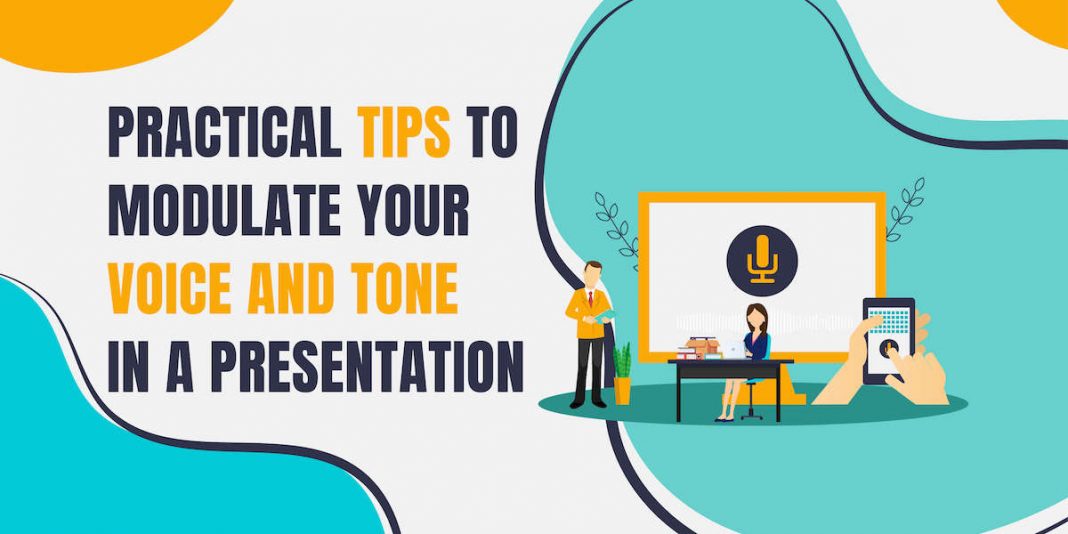Have you ever delivered a presentation and wondered why the audience was not intrigued? Your content was perfect and appropriate for the viewers, but something went wrong, and the presentation fell flat. Well, it may be that you did not harness the power of your voice and pay heed to modulation.
Thus, the ability to vary your voice tone, pitch, volume, and pace can elevate your presentation from mundane to memorable, effectively conveying your message and holding your audience’s attention.
In this article, we will take you through the importance of voice modulation and provide practical tips on incorporating it into your presentations.
Why Does Voice Modulation Matter?
Voice modulation is more than just a technique; it is a powerful tool for communication. You can convey emotion, emphasize key points, and create a dynamic and engaging delivery by varying your voice tone and other vocal elements.
Voice modulation adds depth and richness to your presentation, making it more compelling and memorable for your audience. Whether you deliver a persuasive speech, lead a training session, or pitch a new idea, mastering voice modulation can help you connect with your audience on a deeper level and leave a positive impression.
Tips for Effective Voice Modulation
1. Practice Vocal Warm-Up Exercises
If you have an upcoming presentation, it is essential to remember that your voice is one of your most valuable tools. Warm your voice with some vocal exercises beforehand to ensure you perform best. It not only improves your vocal range, flexibility, and clarity but also helps you relax and calm any pre-presentation jitters.
Some simple exercises include humming, lip trills, and vocal scales. Doing these helps ensure your voice is ready to go and you can speak confidently and clearly throughout your presentation.
2. Focus on Pitch Variation
One helpful technique to make your presentation more engaging and impactful is experimenting with your pitch. Adjusting the pitch allows you to add interest and emphasis to important points you want to convey to your audience.
For instance, a higher pitch can help you express excitement or enthusiasm, while a lower pitch can help convey seriousness or authority.
By alternating between these pitches, you can maintain your audience’s attention and prevent your voice from sounding monotonous.
Let us understand it further with the iconic narration of “Still I Rise” by Maya Angelou. Pay attention to how she changes the pitch and seamlessly conveys an array of emotions.
3. Adjust Your Volume
Focus on your volume levels throughout the presentation and adjust them accordingly to suit the content and mood. Speak louder to emphasize important points or to command attention, and lower your volume for more intimate or reflective moments. Effective use of volume can help create a sense of dynamics and drama in your presentation.
For example, a higher volume can be used to state shocking facts, while a lower volume can showcase grave situations.
4. Control Your Pace
Be mindful of your speaking pace and vary it to maintain interest and engagement. A varied pace can keep your audience engaged and make your presentation more dynamic and compelling.
To deliver complicated information, you can slow down, build excitement and assertiveness, and fasten the pace.
Have a look at Steve Jobs’ iPhone launch in 2007. In the presentation, Jobs varies his pace to deliver different information. While talking about the efforts of his innovation, he uses a slow pace and conveys the gravity of the situation. However, while launching the iPhone, he increases his pace, creates a sense of excitement, and instantly elevates the energy of the room.
5. Use Pauses for Effect
Silence is often underrated, but it can be a powerful tool in communication. When used strategically, pauses help accentuate your speech, give your audience ample time to process information, and create a sense of anticipation.
By pausing before and after essential points, you can emphasize your most critical messages and allow your audience to reflect on them. You can also use pauses between topics to signal transitions and provide a logical structure to your presentation.
Incorporating pauses into your speech can help create a rhythm that makes it easier for your audience to follow along. It keeps them engaged and invested in what you are saying.
For example, in Steve Jobs’ commencement address, he strategically pauses between sentences, allowing the audience to fathom his message correctly and ensuring a subtle rhythm throughout his speech.
6. Be Mindful of Your Tone
Your tone can convey much information beyond just your words. Pay attention to your tone and adjust it to match the content and context of your presentation.
Use a warm tone to create rapport with your audience, a confident tone to convey authority, and a passionate tone to inspire action. Your tone sets the mood and tone of your presentation, so make sure it aligns with your message and objectives.
7. Record and Review Your Delivery
Record yourself delivering your presentation and listen back to identify areas for improvement. It will allow you to pay attention to your voice modulation, pacing, and tone and adjust as needed.
When listening to the recording, note any areas where you may have sounded monotone or rushed or where your tone or pacing seemed off. You can improve these areas to engage your audience better and hold their attention.
Once you have identified areas for improvement, it is time to start practicing. Try delivering your presentation with different vocal techniques until you find the right balance. It might involve slowing down your pacing, emphasizing certain words or phrases, or varying your tone to create more interest and engagement.
Conclusion
Voice modulation is a powerful tool to enhance your presentation. Adjusting your voice according to the content can profoundly impact the audience and help you become a better presenter.
Thus, experiment with different techniques, practice regularly, and become a good communicator capable of captivating and inspiring audiences with your voice.
